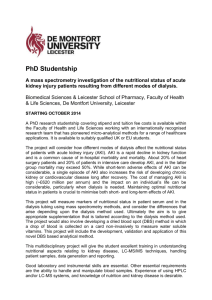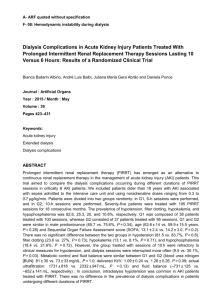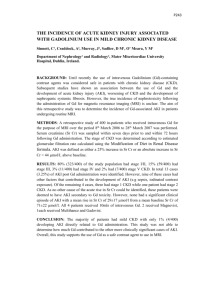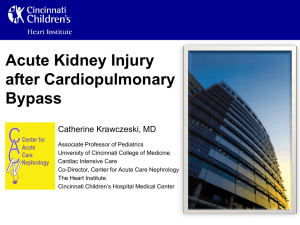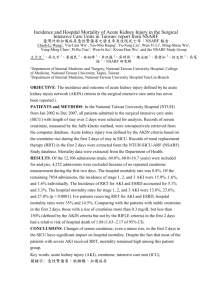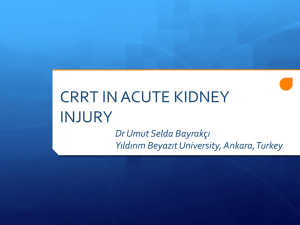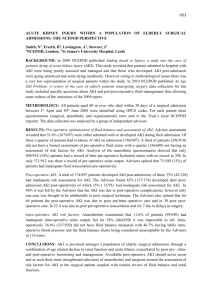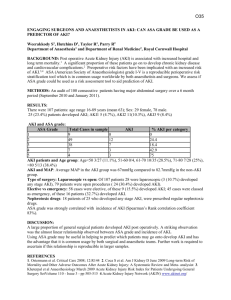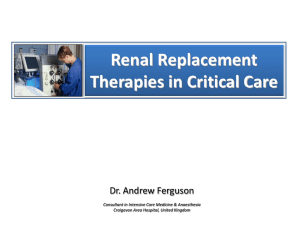Current Approaches to Renal Supportive Therapy and AKI
advertisement
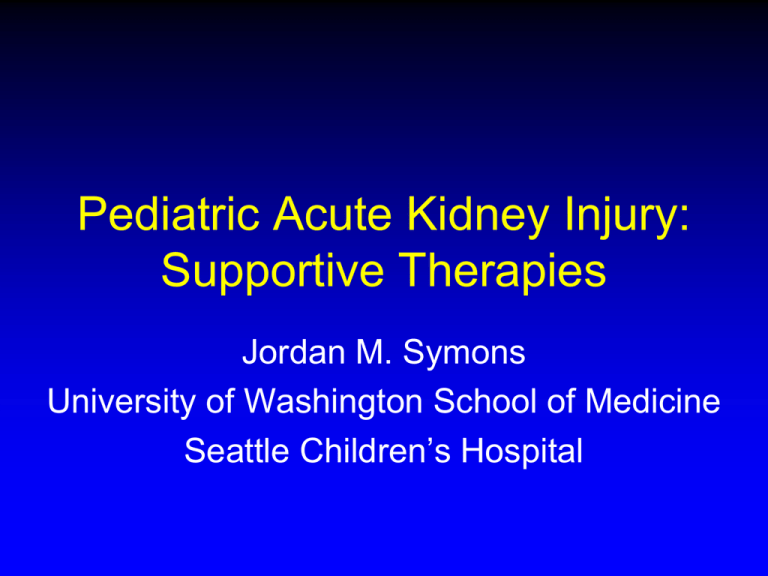
Pediatric Acute Kidney Injury: Supportive Therapies Jordan M. Symons University of Washington School of Medicine Seattle Children’s Hospital Stage-Based Management of AKI Kidney Intl Supplements (2012) 2: 19-36 Natural History of Acute Kidney Injury (AKI) What Goes Wrong in AKI? Volume issues • Volume overload – Pulmonary edema – Tissue edema – Congestive heart failure • Hypertension (+/-) Metabolic issues • Chemical imbalance – – – – Hyperkalemia Metabolic acidosis Hyperphosphatemia Hyponatremia • “Uremic” symptoms Conservative Management of Established AKI: Diuretics • Increase urine output • Improve fluid balance • Permit delivery of fluid to patient – Nutrition, other therapies • May augment loss of potassium Do Diuretics Help in AKI? Bagshaw CCM 2008 36(4) 8 non-randomized studies 6 randomized studies 1. Majority of ICU patients get diuretics 2. But no improvement in clinical outcomes Management of Established AKI: Pharmacotherapy Attempted Therapies • Diuretics • Mannitol • Dopamine • Fenoldopam • Glucocorticoids • Atrial natriuretic peptide • N-acetylcysteine (other than contrast-induced AKI Definitive Therapies • Hmmmm . . . . . Conservative Management of Established AKI: Traditional Approach • • • • • Limit fluid intake Limit input of retained substances Augment losses (diuretics) Try not to mess up Wait and Hope Kolff Rotating Drum Kidney: 1940s From Patient • ~20 meters of sausage casing (2.4m2) • Prime volume 2 liters • Clearance 140 – 170 ml/min First 16 patients died Back To Patient Goals of Renal Replacement Therapy (RRT) • Restore fluid, electrolyte and metabolic balance • Remove endogenous or exogenous toxins as rapidly as possible • Permit needed therapy and nutrition • Limit complications RRT Options in AKI • Hemodialysis, Peritoneal Dialysis, CRRT – Each has advantages & disadvantages • Modality choice guided by – Patient Characteristics • Disease/Symptoms • Hemodynamic stability – Goals of therapy • Fluid removal, electrolyte correction, or both – Availability, expertise and cost Walters et. al. Pediatr Nephrol 2008 Hemodialysis Time Remaining: 1:30 Blood Flow Rate: 300 ml/min Dialysate Flow Rate: 500 ml/min Ultrafiltration Rate: 0.3 L/hr Total Ultrafiltrate: 1.5 L/hr • Blood perfuses extracorporeal circuit • Machine mixes dialysate on-line • High efficiency system • Requires vascular access; anticoagulation • Technically complex • May be poorly tolerated by critically ill patient Peritoneal Dialysis • Sterile dialysate introduced into peritoneal cavity through a catheter Dialysate • Possibly better tolerated • Lots of pediatric experience in chronic setting Peritoneal Space • Low efficiency system • Risk for infection Effluent Collection Continuous Renal Replacement Therapy (CRRT) • Common ICU modality • Technically similar to HD – SLOW: ?Better tolerated by ICU patient? – CONTINUOUS: Preserve metabolic stability; maintain fluid balance for oliguric patients who require high daily input (IV medications, parenteral nutrition) RRT for AKI: Which Modality is Best? In-hospital mortality No Difference in Survival Rabindranath et al., Cochrane Database of Systematic Reviews (2007) RRT for AKI: Which Modality is Best? Survival by Modality 100% 90% 80% 70% 60% 50% 40% 30% 20% 10% 0% Years of study: 1992-1998 N=226; Mean age 6y; Mean wt 25kg P<0.01 (HD vs other) 81% 40% Hemofiltration (N=106) 49% Peritoneal Dialysis (N=59) Hemodialysis (N=61) Bunchman et al., Pediatr Nephrol (2001) 16:1067–1071 Overall survival was 58% across all centers CJASN 2007 2:732-8 Impact of Volume Overload Foland JA et al: Crit Care Med 2004SL et al: Pediatrics 2001 Goldstein Gillespie **p=0.01 R et al: Pediatr Nephrol 2004 *p=0.02; N=113 Sutherland et al: AJKD 2010 “Volume Overload is the Enemy” Hazard Ratio 3.02 (1.50-6.10) Kaplan-Meier survival estimates, by percentage fluid overload category Higher Dose: A Better Outcome? N=425 Hazard Ratio (95% CI) Group 1 1 Group 2 0.51 (0.35-0.72) Group 3 0.49 (0.35-0.69) Group 1: 20ml/kg/hr Group 2: 35ml/kg/hr Group 3: 45ml/kg/hr Ronco, et al. Lancet 2000 Intensity of Renal Replacement in AKI: No Difference? VA/NIH Acute Renal Failure Trial Network, NEJM, 2008 RENAL Replacement Therapy Study Investigators, NEJM, 2009 High Dose of CRRT for Pediatric Patients CRRT Dose N Survivors Hazard Ratio (95% CI)* Low Dose 43 <25.6ml/kg/hr High Dose 44 >25.6ml/kg/hr 23 0.810 (0.418-1.57) 17 1.23 (0.637-2.39) *p=0.533 Gillespie, Pediatr Nephrol 2004 RRT: Effective But Not Perfect Strengths • Volume control – Fluid removal from vascular compartment • Metabolic control – Electrolyte removal – Uremic retention molecule removal Weaknesses • Adapted equipment – Nothing specific for smaller children • No auto-feedback – Targets programmed by provider • “Blunt” metabolic control – Hard to fine-tune – Does not effectively address immune issues A Dedicated Neonatal CRRT Machine? • Lines and filters to limit extracorporeal blood volume • Hardware and software accurate for low flows and low UF volumes • Dedicated rather than adapted • Safe and reliable Claudio Ronco with the Cardio Renal Pediatric Dialysis Emergency Machine (CARPEDIEM) Summary • Current approach to AKI is supportive, addressing issues after AKI established • PD, HD, and CRRT can all have a role – Clear ability to control volume – Evidence for metabolic control • Goals for dose in AKI remain unclear • New technology may offer opportunities for broader application & improved care Early dialysis with Kolff artificial kidney, Mt Sinai Hospital, New York, 1948
